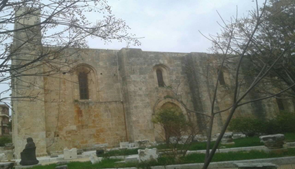The Tartous Museum is a matchless archeological icon that tells a deep-rooted history since it is a cathedral, the largest and most beautiful part of which was built in the mid-12th century in the Crusader era on the ruins of a Marimian church.
It is said that St. Paul participated in its construction, and the cathedral (museum) was influenced by the Byzantine architecture and the architecture of the Eastern churches.
It was considered the most important shrine for Christian pilgrimage in the Byzantine era because the altar of the cathedral, according to historical narrations, was launched by Saint Peter during his journey from Jerusalem to Antioch. While the icon of the Virgin was drawn by Saint Luke in the cathedral, but the Crusaders took it with them as they left, that is why it was called the Pilgrim’s Church or the Virgin’s Church.
According to the documents of the Directorate of Antiquities of Tartus and the secretariat of its National Museum, when Al-Zahir Baybars attacked it in the mid-13th century (1265 AD), the defenders of the cathedral proposed to demolish it so that it would not fall under the control of the Mamluks, but Pope Clement IV rejected the idea . He decided to strengthen the cathedral by strengthening the two rear towers and building two additional towers in front, but currently there is no trace for these towers.
In the mid-nineteenth century, the Ottomans turned it into a mosque. They built a minaret on it in the northwest corner adding a mihrab in the southern wall, and it became a barracks for the Turkish army. In 1920 it was made a refugee shelter by the French Governor at the time of the mandate period. In 1956 it became a national museum of Tartus province with archaeological register No. 8 of 14 May 1958.
The dimensions of the cathedral “museum” are 40-34.5 m, with a height of 17 m, and it consists of three arcades; one in the middle and two side corridors. These arcades were built on the pillars of cross-section columns, showing the influence of Gothic art on the decoration of the columns. The western facade of the cathedral has five windows spread over the hallways and illuminates the nave of the cathedral. On the eastern side, there is a window illuminating the temple, and two towers at the eastern ends of the church (north and south), each have a room for worship and defense of the church.
The Tartous Museum displays archaeological exhibits dating back to several historical eras. There is a collection of statues of men and women making sacrifices to the gods brought from the Amrit region and dating back to the 5th century BC. The Museum has a collection of pottery, bronze and seals from the Tel Kazel site dating back to the Persian and Hellenistic eras. There is also a collection of bottles, pitchers, cups, pottery, and saddles from the Greek, Roman and Byzantine periods found in the coastal region. In addition to three mosaic paintings from the Roman period; Poseidon, God of the Sea, shepherd in front of his flock, and a seated woman representing the goddess Alpheus, the fertile and nature goddess.
Among the contents of the museum is also the Phoenician Baal, the god of rain and clouds, which is carved from black basalt and dates back to the seventh century BC.
There is a Roman marble sarcophagus on which Eros, the god of love, and Dionysius, the god of wine, were carved from the inside. On the outside, there is a carving of Athena, the goddess of war, which dates back to the third century AD.
The museum also has a collection of human coffins, one of which is marble dating back to the end of the 5th century BC and another of black basalt representing the Assyrian style.
Various marble and basaltic artifacts dating back to different periods are displayed in the museum garden.
Amal Farhat

